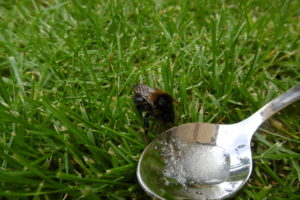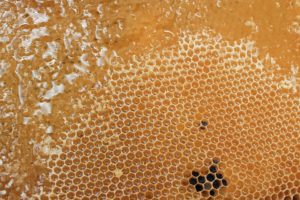
June 1st, 2018 by
Bee Nice This Summer
 Honey and beeswax are used for a massive range of things around the globe Bees are one of the most important creatures on the planet. They pollinate flowers, enabling us to farm and grow crops. They also provide us with honey, which is a key ingredient of countless foods, and beeswax, which has hundreds of practical and medical uses. Even bees themselves have too many uses in medicine for us to list here! Unfortunately, the decrease in natural bee habitats coupled with the increase in the use of bee-harming pesticides has led to wild bee populations dropping dramatically. Environmentally, this is very bad news, but it could also lead to real problems for the countless industries that rely on bees! This means the health of bees is a real concern. As bees struggle to find flowers to feed on, they can end up exhausted. When a bee is tired out, it won’t have the energy to fly, which is essentially a death sentence for a bee! If you see a bee on the ground, please don’t squash it! Chances are the poor thing is simply too tired to fly. Instead, you can help the bee out by reviving it. It might not seem like much, but even the smallest gesture can really help provided we all know what to do when we see a bee that’s in trouble.
Honey and beeswax are used for a massive range of things around the globe Bees are one of the most important creatures on the planet. They pollinate flowers, enabling us to farm and grow crops. They also provide us with honey, which is a key ingredient of countless foods, and beeswax, which has hundreds of practical and medical uses. Even bees themselves have too many uses in medicine for us to list here! Unfortunately, the decrease in natural bee habitats coupled with the increase in the use of bee-harming pesticides has led to wild bee populations dropping dramatically. Environmentally, this is very bad news, but it could also lead to real problems for the countless industries that rely on bees! This means the health of bees is a real concern. As bees struggle to find flowers to feed on, they can end up exhausted. When a bee is tired out, it won’t have the energy to fly, which is essentially a death sentence for a bee! If you see a bee on the ground, please don’t squash it! Chances are the poor thing is simply too tired to fly. Instead, you can help the bee out by reviving it. It might not seem like much, but even the smallest gesture can really help provided we all know what to do when we see a bee that’s in trouble.
How to Revive a Bee
Step 1
If you see a bee on the ground, first make sure it’s in a safe, sheltered place. Tired bees make an easy meal for many predators as they can’t defend themselves. Pick the bee up using a tissue and take it somewhere safe if it’s exposed.
Step 2
Mix 2 teaspoons of white granulated sugar with 1 teaspoon of water to create a syrup for the bee to drink. Don’t use too much water – you want the bee to drink your syrup, not drown in it! If you want to make more or less syrup, you can; just make sure the ratio is roughly the same (2 parts sugar to 1 part water).
Step 3
 A quick syrupy meal will help the bee recover in no time Place the syrup in front of the bee using a spoon or a saucer. If the bee is too tired to move, pick it up using a tissue and place it on the spoon or plate itself. Don’t worry – bees aren’t interested in stinging you at the best of times, but it’ll be too exhausted to sting you even if it wanted to!
A quick syrupy meal will help the bee recover in no time Place the syrup in front of the bee using a spoon or a saucer. If the bee is too tired to move, pick it up using a tissue and place it on the spoon or plate itself. Don’t worry – bees aren’t interested in stinging you at the best of times, but it’ll be too exhausted to sting you even if it wanted to!
Step 4
Wait and make sure the bee actually drinks the syrup. You should see a little tongue flick out of its mouth and start sucking up the syrup!
Step 5
After a few minutes, the bee’s wings should start working again. Before long it’ll be revived and will have the energy to fly off, fresh as a daisy! You should feel good about yourself – this small gesture could make a big difference to the environment!
What Not to Do
 Bees eat their own honey, but honey from elsewhere can be harmful Don’t squash bees! They’re harmless and pose no threat to you. By squashing them you’re harming the environment and leaving the bee’s stinger exposed, which children or animals could touch and be hurt by. Don’t use raw or demerara sugar. Only ever use white granulated sugar – other types of sugar contain impurities that can harm the bee. Don’t ever feed a bee honey! Bees should only ever eat their own honey. Other honey from other bees might not be suitable, especially if it’s imported. It can also contain harmful spores or bacteria that can kill bees. Don’t mix too much water when making syrup. We’ve mentioned this already, but the syrup should be thick and sticky. If it’s too watery, it’ll be like dropping the bee into a sugary puddle, and it’ll drown.
Bees eat their own honey, but honey from elsewhere can be harmful Don’t squash bees! They’re harmless and pose no threat to you. By squashing them you’re harming the environment and leaving the bee’s stinger exposed, which children or animals could touch and be hurt by. Don’t use raw or demerara sugar. Only ever use white granulated sugar – other types of sugar contain impurities that can harm the bee. Don’t ever feed a bee honey! Bees should only ever eat their own honey. Other honey from other bees might not be suitable, especially if it’s imported. It can also contain harmful spores or bacteria that can kill bees. Don’t mix too much water when making syrup. We’ve mentioned this already, but the syrup should be thick and sticky. If it’s too watery, it’ll be like dropping the bee into a sugary puddle, and it’ll drown.
Other Ways to Help Bees
Fill an egg cup with a sugary syrup mixture – again, use 2 parts sugar for every 1 part water – and put it in your garden. Put it high up to reduce the risk of ants getting to it. The best place to put it is in a hanging basket or window box, where bees will naturally be drawn to it anyway. You can also buy a bee and butterfly feeder that you can put up in your garden. Try and get one with bright, contrasting colours – this is what bees will be drawn to. Consider donating or volunteering with the Bumblebee Conservation Trust, the UK’s leading bumblebee charity. If you can’t donate, give them a follow on social media so you can stay informed. Keep your garden clean and tidy. A dirty garden is likely to attract pests and other insects who can prey on bees or compete with them for food. Use a safe hard surface cleaner like Simply Spray and Walk Away to remove green mould and algae from your garden path to deter pests and make life easier for bees!
Comments
Leave a reply
Your e-mail address will not be published. All fields are required


